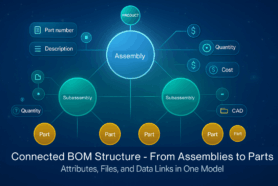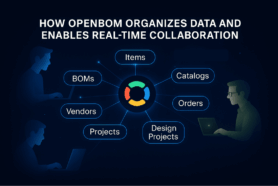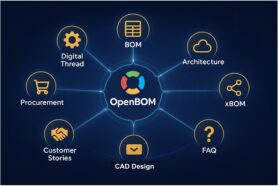
Despite the widespread adoption of digital technologies like computers, mobile devices, the internet, and various digital services, Excel continues to be a primary tool for Bill of Materials (BOM) sharing among engineers and manufacturing companies.
This amazing and unfortunate preference was highlighted in a LinkedIn poll conducted by Amen Jlili, (SOLIDWORKS API Wizard), which revealed that a significant majority of engineers still rely on Excel or PDF for BOM sharing, accounting for a combined 76% usage.
While I knew for a long time that spreadsheets were “the best PLM tool in the world”, the poll caught my curiosity and surprised me that SOLIDWORKS users in 2024 are still preserving the strong ongoing reliance on Excel for BOM and data sharing. I started to explore this topic in depth working with many engineering and manufacturing companies.
My thoughts about Excel go back to 2009 when I first thought – why do I like my PLM excel spreadsheets and then my thoughts about usage of spreadsheets – PLM Excels from Odes to Woes.
The conflict here is very interesting. On one side everyone knows that Excel is not a good tool, but still use it.
5 Reasons Why BOM is More Complex Than a Spreadsheet and Why You Need to Appreciate It -).
As we move forward into 2024, it’s crucial to address why Excel remains so prevalent and how the industry can evolve towards more effective tools for data management and collaboration, such as OpenBOM.
We’ve been making good progress with OpenBOM, but still I can see we didn’t really start a massive migration of engineers. OpenBOM, with nearly 500 reviews on G2, demonstrates how we help engineers and manufacturing companies. One of my favorite reviews says -“OpenBOM is the tool that should have existed 20 years ago.”
At the same time, I realized that we haven’t started the process of mass migration yet.
Working with thousands of engineers, we realize that using spreadsheets is a habit that we all do because it is easy and convenient. As one of my fellow colleagues says – no matter what data problem you ask an engineer to solve they will bring you an Excel after 20 min.
In my article today, I want to talk about the major trend we live in these days and how this trend will change what we do in the future.
1. Digital Transformation: A Major Industry Trend
The shift towards digital transformation represents a fundamental change in how we manage and share information. The reality of the existing data management paradigm is defined by the data management and user experience such as folders/files/spreadsheets paradigm.
This is what everyone does and this is how the brain was trained for the last 30+ years. A digital transformation that started a decade ago, introduced hugely popular web and mobile applications into engineering space. We like our mobile apps and websites, so we want our professional environment to be the same. What adds to this changing paradigm is the massive reliance on smart usage of data. We wonder how smart are applications and services (from Google Maps and Waze to ChatGPT) in helping us in our everyday lives.
This transition from a traditional file/folder/email system to connected services promises to revolutionize every aspect of engineering and manufacturing processes. The new data management and collaboration paradigm will be emerging.
Yet, despite these advancements, the reliance on existing file and folder paradigms remains strong. Many in the industry continue to see these traditional methods as the best way to store and maintain control over their files, thereby avoiding dependence on various PDM/PLM systems for managing BOM and sharing data.
The Endurance of the File/Folder/Spreadsheet Paradigm
The enduring preference for the file/folder system can be attributed to its simplicity and the direct control it offers over data. This approach has been deeply ingrained in the industry’s practices, making the shift to new methodologies a significant challenge.
However, as we move towards more integrated and connected services, the limitations of this paradigm are becoming increasingly apparent, highlighting the need for more flexible and efficient data management solutions.
The key element of this transformation lies in the simplification of services, seamless integration with existing successful engineering solutions, and timesaving of the actions they can perform and the magic factor of data intelligence.
The Shift Towards Service, Data Exchange, and Data Magic
The future of engineering and manufacturing lies in the transition to software solutions that prioritize the exchange of services and data over traditional files and spreadsheets. This transformation is already underway, with many organizations adopting new technologies that facilitate real-time data sharing and collaboration. The move towards these interconnected systems represents a significant step forward in improving efficiency, reducing errors, and enhancing the overall speed of development processes.
The “icing on the cake” will be offering the magic capabilities of AI tools and what they can do by transforming your data into a decision and easy process capable of replacing old and ugly spreadsheets.
Conclusion: Bridging the Old and New Worlds with OpenBOM
The era of digital transformation is reshaping the landscape of systems and communication, moving away from the old folder/files paradigm towards connected services that enable seamless data exchange. The magic of BOM AI will open a new path towards more efficient data management and collaboration.
OpenBOM stands at the forefront of this transition, offering a unique solution that not only supports the import and export of traditional formats but also enables real-time data sharing and instant collaboration. As a bridge between the past and the future, OpenBOM represents an online service for those looking to navigate the complexities of modern data management and collaboration. I invite you to explore OpenBOM and discover how it can transform your approach to BOM management and beyond.
REGISTER FOR FREE and check how OpenBOM can help you today and work together with us to create a better future for data management, collaboration, and intelligence in engineering and manufacturing.
Best, Oleg
Join our newsletter to receive a weekly portion of news, articles, and tips about OpenBOM and our community.










